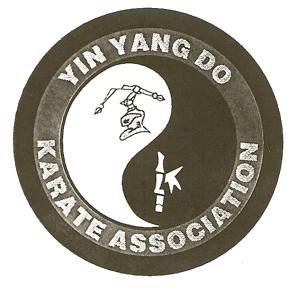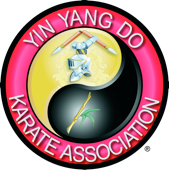Before learning about the Yin Yang Do Karate Association, we must first review the history of Karate.
History of Karate
In the past, most martial arts were practiced in secret with no written records. Many of the scant records that were maintained were destroyed or lost, mostly due to various wars. This scarcity of records makes researching our history very difficult and unreliable. Much of the information available today is hearsay and speculation. The information provided is the most commonly recognized version of the truth as we know it.
The historical roots of karate can be traced to ancient India. It is thought that at the end of the fifth century A.D. a Buddhist monk named Bodhidharma traveled from India to China on foot to instruct at the Shaolin monastery in Henan province. Bodhidharma found the Chinese monks lacking in physical and mental development and unable to endure the rigors of his training. To remedy this problem, he incorporated a physical fitness program based on exercises and self-defense movements into his system of teaching Zen Buddhism. This eventually became the kung-fu system of Shaolin. As the art proliferated throughout China, variations and local styles appeared.
The fighting techniques of China were subsequently carried to the offshore islands, most notably Okinawa, by waves of immigrants, refugees, and priests. Weaponless combat, called Te (hand) had already existed in Okinawa.
Around 1400 A.D., the Japanese Sho dynasty consolidated its civil administration in Okinawa with the prohibition and confiscation of all arms, leading to an increased interest in fighting with hands, feet, farm implements, and self-made weapons. Add to this the replacement of Chinese civil emissaries to Okinawa with military personnel, some of who were skilled in Chinese boxing, and a tremendous advancement in the development of karate occurred.
History of Shorei-Ryu and the Yin Yang Do Karate Association
Once again we must consider that much of the information available today regarding Shorei-Ryu and the Yin Yang Do Karate Association is only available as hearsay, speculation, and extrapolation. The information contained in the page is the most commonly recognized version of the truth as we could best determine.
Shorei-Ryu’s origins can be traced back to Bodhidharma and the Shaolin Temple. Around 1830, Sokon “Bushi” Matsumura (1809-1901) divided the various Okinawan styles then taught in Okinawa into three categories: Naha-Te, Shuri-Tem, and Tomari-Te, named after the cities in which they were practiced. Karate master Choki “Saru” Motobu (1871-1944), a student of Matsumura and later Yasutsune “Ankoh” Itosu (1830-1915), is considered the “father of Shorei-Ryu.” Also important in the evolution of Shorei-Ryu is the Chinese master Shang Tsao Hsing ( – ), who integrated the internal Chinese systems of hsing-l and pa-kua with the external systems of Shaolin Gung-Fu and others. The elder Haing passed on his knowledge to his nephew, T’ung Gee Hsing ( – ), When T’ung Gee Hsing was living in the Chinese settlement of Kume Mura in Okinawa, he was sought by Motobu for training. (This information is widely questioned at the present time in Karate research, due to the fact that there is little evidence or record of Tung Gee Hsing.)
It is reported by the late Robert A. Trias that in 1940 Hsing traveled to the Solomon Islands as a missionary seeking to convert the natives. There, in 1942, he met Robert A. Trias (1922 – 1990), an American serviceman who was a middleweight boxing champion in the U.S. Navy during the war. Following a memorable sparring encounter, Trias began training with Hsing. Following his honorable discharge, Trias was, in 1946, the first to introduce karate on any kind, as well as the Shorei-Ryu system, in the United States. Trias founded the United States Karate Association, wrote several books, dedicated his life to the dissemination of Karate in the United States, and later further developed the art of Shorei Ryu into his style of Shuri Ryu, of which both Shorei Ryu and Shuri Ryu appear to be a conglomeration of various Japanese and Okinawan arts.
Philip W. Koeppel (1938 – ), a student of Master Trias, began training under Richard Kim (1917 – 2001) and trained under Yoshiho Kawagushi (1926 – 2008) in the style of Wado Ryu, in Yokohama, Japan in 1956. During that time, while stationed in Hawaii with the U.S.Navy, he continued training under Adriano Emperado (1926 – 2009) in Hawaii, who was one of the founders of a conglomerate art called “Kajukenbo”. In 1963, Master Koeppel co-promoted the first World Karate tournament in Chicago and served as a regional director of Trias’ U.S.K.A. until 1981. He also studied under Fusei Kise ( 1935 – ) in Okinawa and later Yuichi Kuda (1928 – 1999). In 1983, Koeppel founded his own karate organization, called the “United States Karate-Do Kai”. headquartered in Peoria, Illinois. The U.S.K.K. remains extremely active in promoting worldwide karate tournaments, workshops, and events. Philip Koeppel changed his studies in the 1980s to focus on Matasumora Seito Shorin Ryu, which is a total Okinawan style.
Rev. William H. Foster (1913 – 1994), a student of Master Koeppel, began training in the martial arts in 1937. Having joined the Marines in 1935, he was transferred two years later in Shanghai and befriended an expert in Chinese Art names Lo Wei Doun ( – ), with whom he trained for some time. While in China, Rev. Foster also trained in Judo. After returning to the U.S. and having trained in a variety of places, Rev. Foster met Master Koeppel in 1960, and became Mr. Koeppel’s first Karate student, studying the art of Shorei Ryu as it was being taught by Master Trias in the 1960s. Master Koeppel and Reverend Foster eventually would operate a karate dojo together in Peoria, Illinois. In 1968, Reverend Foster moved to Kenosha, Wisconsin, and started teaching karate there. He began with students turned over to him by Sensei Timothy D. Hillary (1944 – ), a Shotokan stylist who had trained in Japan under Masaaki Ueki of the U.S.K.A., but left that organization in 1973 and founded the Yin Yang Do Karate Association; he then renamed the art that we practice from Shorei Ryu (also called Shorei Goju Ryu in the early years) to Shorei Kempo, which is the current art that we continue to practice.
Association Crest


Meaning of the Yin Yang Do Patch
The Yin Yang symbol is known throughout Asia and represents the extremes in nature such as light and dark, male and female, hard and soft, and good and bad.
It is desirable in life to try to find the middle way or path, and to stay away from extremes.
In designing the Yin Yang Do logo, Shihan Foster united the philosophy of the Far East with the philosophy of Christian chivalry.
The bamboo on the lower part of the patch signifies the strength and resilience of the people on the Far East.
The top of the patch shows a knight with a broken lance. The knight represents Christian chivalry and is Reverend Foster’s family crest.
The main code of Christian chivalry is to serve those who are unable to defend themselves.
Reverend Foster’s family motto is “though broken, fight on”. This is where the broken lance on the knight’s helmet came from.
When the Association was being formed, one of Shihan Foster’s students, Earl Pfarr, the first Secretary of the Association, suggested the name Yin Yang Do since he had read a lot about the philosophy on the Yin and Yang. Reverend Foster thought this was a good idea. They built upon this these to form the patch we wear today.